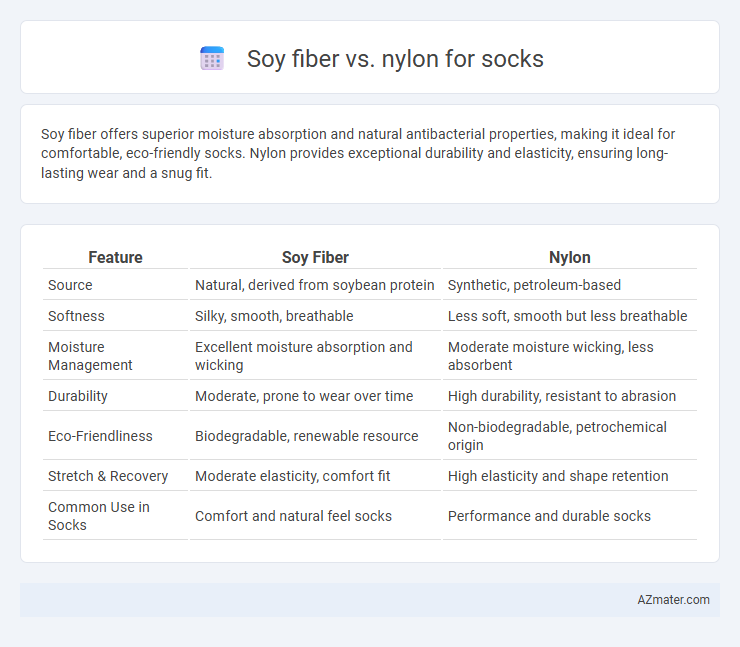Soy fiber offers superior moisture absorption and natural antibacterial properties, making it ideal for comfortable, eco-friendly socks. Nylon provides exceptional durability and elasticity, ensuring long-lasting wear and a snug fit.
Table of Comparison
| Feature | Soy Fiber | Nylon |
|---|---|---|
| Source | Natural, derived from soybean protein | Synthetic, petroleum-based |
| Softness | Silky, smooth, breathable | Less soft, smooth but less breathable |
| Moisture Management | Excellent moisture absorption and wicking | Moderate moisture wicking, less absorbent |
| Durability | Moderate, prone to wear over time | High durability, resistant to abrasion |
| Eco-Friendliness | Biodegradable, renewable resource | Non-biodegradable, petrochemical origin |
| Stretch & Recovery | Moderate elasticity, comfort fit | High elasticity and shape retention |
| Common Use in Socks | Comfort and natural feel socks | Performance and durable socks |
Introduction to Sock Materials: Soy Fiber vs Nylon
Soy fiber offers natural moisture-wicking properties and biodegradability, making it an eco-friendly choice for socks with a soft texture that enhances comfort. Nylon, known for its exceptional durability and elasticity, provides strong wear resistance and helps maintain sock shape during extended use. Comparing soy fiber and nylon highlights a trade-off between sustainability and performance, influencing sock material selection based on consumer priorities.
Origins and Production of Soy Fiber
Soy fiber, derived from the byproducts of soybean processing, is a sustainable and biodegradable material produced through a cellulose-based extraction process that repurposes soybean protein. In contrast, nylon is a synthetic polymer created from petrochemical sources through a polycondensation reaction, resulting in a non-biodegradable material. The eco-friendly origins of soy fiber make it an appealing natural alternative for socks aimed at reducing environmental impact compared to conventional nylon fibers.
Nylon: A Synthetic Staple in Sock Manufacturing
Nylon, a synthetic staple fiber, dominates sock manufacturing due to its exceptional durability and elasticity, providing enhanced shape retention and resistance to abrasion. Compared to soy fiber, nylon excels in moisture-wicking capabilities and quick-drying properties, making it ideal for activewear socks. Its lightweight nature combined with superior tensile strength ensures long-lasting comfort and performance in various sock applications.
Comfort and Breathability: Comparing Wear Experiences
Soy fiber socks offer superior breathability due to their natural moisture-wicking properties, keeping feet dry and comfortable during prolonged wear. Nylon fibers provide durability and elasticity but tend to trap heat and moisture, which can cause discomfort and increase the risk of blisters. Therefore, for optimal sock comfort and breathability, soy fiber is often preferred in warmer conditions, while nylon may be better suited for activities requiring enhanced durability.
Moisture-Wicking and Odor Control Properties
Soy fiber exhibits superior moisture-wicking capabilities compared to nylon, effectively drawing sweat away from the skin to keep feet dry during prolonged wear. Its natural enzyme-based antibacterial properties inhibit odor-causing bacteria, making it an excellent choice for odor control in socks. Nylon, while durable and moisture-resistant, tends to retain odors and lacks the inherent antimicrobial benefits found in soy fiber.
Durability and Longevity: Which Sock Lasts Longer?
Soy fiber socks offer moderate durability due to their natural moisture-wicking and antibacterial properties but tend to wear out faster than nylon blends under heavy use. Nylon enhances sock longevity by providing superior strength, abrasion resistance, and elasticity, making it ideal for high-impact activities. Socks with higher nylon content typically last longer, maintaining shape and performance through repeated wear and washing.
Environmental Impact: Sustainability of Soy Fiber vs Nylon
Soy fiber is biodegradable and derived from renewable soy protein, significantly reducing environmental impact compared to petroleum-based nylon, which relies on fossil fuels and produces non-biodegradable waste. The production of soy fiber consumes less energy and emits fewer greenhouse gases, promoting sustainability in textile manufacturing. Nylon's manufacturing process often involves toxic chemicals and results in microplastic pollution, making soy fiber a more eco-friendly choice for sustainable sock materials.
Skin Sensitivity and Hypoallergenic Qualities
Soy fiber socks offer superior skin sensitivity benefits due to their natural protein structure, which closely mimics human skin, reducing irritation and providing a soft, breathable feel ideal for sensitive skin. Nylon, a synthetic fiber, tends to trap moisture and can cause friction, potentially leading to skin irritation or allergic reactions in individuals with hypersensitive skin. Hypoallergenic properties are more pronounced in soy fiber socks, as they resist bacteria and odor buildup better than nylon, making them a preferred choice for allergy-prone or sensitive skin users.
Cost and Accessibility of Soy Fiber and Nylon Socks
Soy fiber socks typically offer a more eco-friendly and cost-effective option compared to nylon socks, with prices often lower due to the sustainable production of soy protein-based materials. Nylon socks, while generally more widely available and accessible in various retail outlets, tend to be slightly more expensive due to synthetic manufacturing processes and higher durability characteristics. Consumers valuing affordability and environmental impact often prefer soy fiber socks, whereas those prioritizing widespread availability and elasticity may lean towards nylon options.
Conclusion: Choosing the Right Material for Your Needs
Soy fiber socks offer natural moisture-wicking, breathability, and biodegradability, making them ideal for eco-conscious consumers seeking comfort and sustainability. Nylon socks provide superior durability, elasticity, and abrasion resistance, perfect for high-performance activities or prolonged wear. Selecting between soy fiber and nylon depends on prioritizing either environmental benefits and softness or strength and longevity for your specific sock needs.

Infographic: Soy fiber vs Nylon for Sock
 azmater.com
azmater.com